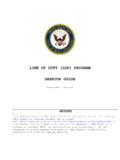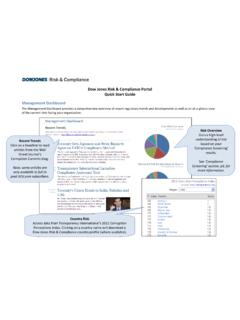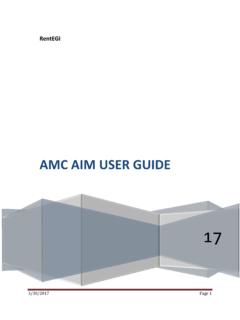Transcription of Digital Signals Integrity Tutorial - Sonnet Software
1 Digital Signals Integrity Tutorial Sonnet Microstrip Models Thanks to Sonnet s Application Engineer, Greg Kinnetz and the TCNJ Spring 2014 ELC 441 Digital Engineering Systems Class, Adrian Alshuaili, Ricardo Alves, George Banis, Jason Boxer, Vincent Carbone, Stephen Coppi, Liliane DeSilva Costa, Orlando DeLaCruz, Daniel Fisher, Jordan Freedner, Pedro Gilberto Augusto, Andrew Gildea, David W. Hand, Christopher Liang, Matthew Loewenstein, joseph Maco, Alexander J. Manoski, Wayne Philip Marshall, Jared Ariel Milburn, Timothy Nugent, Jeffrey R. Owens, Kunal Saxena, Jason Robert Scott, Timothy Skinner, Christopher J. Smith, Edward R. Spencer, Nicholas Steponanko, and Yevgen Tkachuk -- Professor Joe Jesson, 203-613-3344 Digital Design Introduction & Design Rules What are the Issues of HS Digital Design Today? Relationship between Time and Frequency Domain Rise Time and Fourier Frequency Components Digital Square Wave Generates Odd Harmonics Relationship between the Logic Rise Time and Frequencies Generated Electromagnetic Modeling of PCB Traces PCB Microstrip Example EM Modeling of Transmission Lines (PCB Traces on FR4) using Sonnet Sonnet Tutorial 1 Terminated Microstrip Line => Build on FR4, Graph S11 in dB, Plot VSWR, Impedance on a Smith Chart, Sonnet Tutorial 2 Coupled Microstrip Lines => Plot the Near End Crosstalk (NEXT)
2 Using the dB[S21] S-parameter, Current Density Sonnet Tutorial Differential Pair Microstrip Lines => Extract S, Y, Z-parameter, Pi-model, N-coupled, Broadband, and Inductor Files Conclusions of Sonnet as a Digital Signals Integrity Simulation Tool SI Verification Tool Time Domain Reflectometry SI Verification Tool Eye Diagram Mask SI Verification Tool Bit Error Rate Tester (BERT) SI Verification Tool Vector Network Analyzer (VNA) Tutorial Conclusions Text References: Hall, Hall, and McCall, High-Speed Digital System Design, John Wiley & Sons Inc., 2000 Johnson and Graham, High Speed signal Propagation, Prentice Hall, 2003 Digital Engineering Systems Outline Digital Design Introduction & Design Rules Advanced Digital Design Introduction The design guidelines today for high-speed Digital signal Integrity require, as standard: - All PCB traces need to be terminated at a controlled impedance -Reduce Impedance & inductive elements in the return path -Avoid Branched Routing Topology -Design Low-Impedance ground and power distribution paths -Understand how Connectors and Vias change the impedance Note: Beginning Digital engineers often make a mistake in not terminating the input ALL High-impedance (Hi-Z) inputs must be terminated otherwise intermittent results can occur and/or Electro-static Discharge (ESD) can damage the IC.
3 What are the Issues of HS Digital Design Today? Advanced Digital Design Introduction Digital Problems are Manifest in Many Ways and Potential Root Cause Indicated: - Specific ONE bits are read as ZERO or - Transmitted ZERO bits are read as ONE Intersymbol Interference (ISI) due to Impedance Mismatch Impedance Discontinuities Ground Loop, dI/dT - Jitter (Timing Jitter) Thermal Noise Cross Talk Noisy Ground Connections Jitter testing is of growing importance to engineers, as system clock frequencies are increasing inducing intersymbol interference. Current motherboards have high-speed serial bus architectures with rise time of <170 picoseconds and also engineering attention has to be focused on proper buss termination. 1 0 - 2 3 1 1 + 2 1 + 2 + 3 1 + 2 + 3 + 4 1 + 2 + 3 + 4 + 5 Fourier Frequency Components Relationship between Time and Frequency Domain FOURIER SERIES Digital Signals are composed of an infinite number of sinusoidal functions A SQUARE WAVE: Y = 0 for - < x < 0 and Y=1 for 0 < x <.
4 1 Hall, Hall, and McCall, High-Speed Digital System Design, John Wiley & Sons Inc., 2000: 284 - 303 Digital Square Wave Generates Odd Harmonics Relationship between Time and Frequency Domain Actual Spectrum plot generated by Digital Square Waves which illustrates the Frequencies Generated by a 100ps rise time (Tr of ECL Logic Family) 1 Hall, Hall, and McCall, High-Speed Digital System Design, John Wiley & Sons Inc., 2000: 85 Weisstein, Eric W. "Fourier Series--Square Wave." From MathWorld--A Wolfram Web What Frequencies and Amplitudes are Generated? The 10%-90% rise time, Tr, is the key specification for determining the Fourier frequency components and the amplitude. For example, Tr of ECL is approximately 100nsec which, using the rule of thumb, 350 MHz/Tr = GHz Relationship between the Logic Rise Time and Frequencies Generated Digital LOGIC FAMILY TYPICAL RISE TIME CALCULATED signal BW Transistor Transistor-Logic (TTL) 15 ns 24 MHz Low-Power Schottky TTL (LSTTL) 2 ns 175 MHz Complementary Symmetry Metal Oxide Semiconductor (CMOS) ns 230 MHz Gunning Transceiver Logic (GTL) 1 ns 350 MHz Low-Voltage Differential Signaling (LVDS) 400 ps 875 MHz Emitter-Coupled Logic (ECL) 100 ps GHz Gallium Arsenide Logic (GaAs) 40 ps GHz 1 3 5 7 9.
5 Harmonic Number 20dB/decade 40dB/decade T T1Tr Estimating the Frequency Content in a Digital Square Wave The Rise Time of Modern Logic Generates MICROWAVE Frequency Components How do we get this Rule-of-Thumb Rise Time to Frequency Equation? It can be derived from the response of a step function into a filter & time constant tau: Setting V= and V= , calculate the 10-90% risetime in terms of the time constant The frequency response of a 1 pole network is Substituting into the step response yields: Relationship between the Logic Rise Time and Frequencies Generated 1 3 5 7 9 .. Harmonic Number 20dB/decade 40dB/decade T T1Tr Estimating the Frequency Content in a Digital Square Wave )1(/ tinputeVV The frequency response of the Digital network determines the resulting rise or transition time. The majority of the spectral energy content, as shown on the left, will be contained below F3dB tttdBdBFF332121 dBdBFFt33% dBFt3% Microstrip is a commonly used transmission line configuration in a mixed signal Printed Circuit Board (PCB) designs.
6 There are closed form equations that are useful for initial transmission line calculations Most practical PCB circuits are quite complex and quickly exceed the limitations of the equations. For a more complete understanding of transmission line based circuits, an electromagnetic (EM) model is required. Sonnet is a useful tool for Planar EM Simulation. Electromagnetic Modeling of PCB Traces PCB Microstrip Example Advanced Digital Design Introduction Sketch of the Electric and Magnetic Fields surrounding the trace wire on an FR4 substrate Microstrip transmission lines are often found on the top and bottom layers of PCB s. They consist of a trace with a dielectric material and groundplane below. The trace might be exposed to air above it or covered with soldermask. There are numerous equations in papers, books, and Software calculators, which yield good initial values for microstrip transmission line quantities.
7 One of the most important is the Characteristic Impedance Zo. A decent rule of thumb is that the width of a microstrip trace should be approximately twice the dielectric layer height in order to produce a Zo of 50 Ohms. This assumes an FR-4 dielectric material, which has an approximate Relative Permitivity of 1 Hall, Hall, and McCall, High-Speed Digital System Design, John Wiley & Sons Inc., 2000: 7 - 41 PCB Microstrip Example Advanced Digital Design Introduction Here is a screenshot from the freely available AppCAD program from Agilent/Avago 1. In it dimensions for a microstrip transmission line have been entered and the Zo computed. Note that the rule of thumb (W=2*H, for 50 Ohms Zo) is fairly accurate. National Instruments/AWR offers a similar program called TXLINE. 1 AppCAD Utility Page: Sonnet uses a Method of Moments analysis technique to generate frequency domain data for transmission line structures.
8 The particular EM solver formulation is laterally closed, which places Perfect Electric Conductor (PEC) shielding walls around the modelspace. It is straightforward to create or import circuit layouts in Sonnet . There is even a no-cost version of Sonnet ( Sonnet Lite), which we will use in the following slides, to analyze some basic PCB transmission line structures. ( Sonnet Lite is used). For more information and to download Sonnet Lite, please visit the Sonnet Lite website at: Please see the Sonnet documentation for detailed help to get started and setup models. Electromagnetic Modeling of Transmission Lines using Sonnet Sonnet Tutorial Terminated Microstrip Line Advanced Digital Design using Sonnet This exercise will go through the creation of a simple microstrip transmission line terminated in a ideal, 50 Ohms resistor. We will use the dimensions and materials noted on the previous slides. The purpose is to acquaint beginners with the basic use of Sonnet to design and analyze transmission lines for various purposes.
9 When you open a new project a blank layout window will appear. There is a Quick Start Guide window that can assist in model creation. To keep the interface clear we won t use the Quick Start Guide in this Tutorial and instead use the highlighted Menu Bar, Tool Bar, Tool Box, and Stackup Manager Sonnet Tutorial Terminated Microstrip Line Advanced Digital Design using Sonnet The first step is to use the menu command Circuit => Units and ensure the desired units are set. We will use a length unit of mils so the default setting is correct. At this point it is a good idea to save the project under a meaningful name. Please continue to save the project at various points after making changes. Sonnet Tutorial Terminated Microstrip Line Advanced Digital Design using Sonnet The next few steps do not necessarily have to be completed in a specific order. We will define the dielectric layers next. This dialog box can be accessed using the menu command Circuit -> Dielectric Layers or right click on the Stackup Manager and select the same command.
10 In this example, we need to manually enter an Air layer and FR-4 material from the library. Layer thicknesses are not stored in the library and must be manually entered. Sonnet Tutorial Terminated Microstrip Line Advanced Digital Design using Sonnet We will define the metal type next. This dialog box can be accessed using the menu command Circuit -> Metal Types or right click on the Stackup Manager and select the same command. In this example, we need to define a 1oz Copper metal type using the Add Planar button. Once this is defined, we can save some time in the future by assigning the 1oz_Copper metal type for new planar metal in the pulldown list. Sonnet Tutorial Terminated Microstrip Line Advanced Digital Design using Sonnet We will define the analysis box next. This sets the X x Y size of the dielectric layers. This dialog box can be accessed using the menu command Circuit -> Box In this example, we will use a 500 x 400 mil box size and a 2 x 2 mil cell size (grid).



